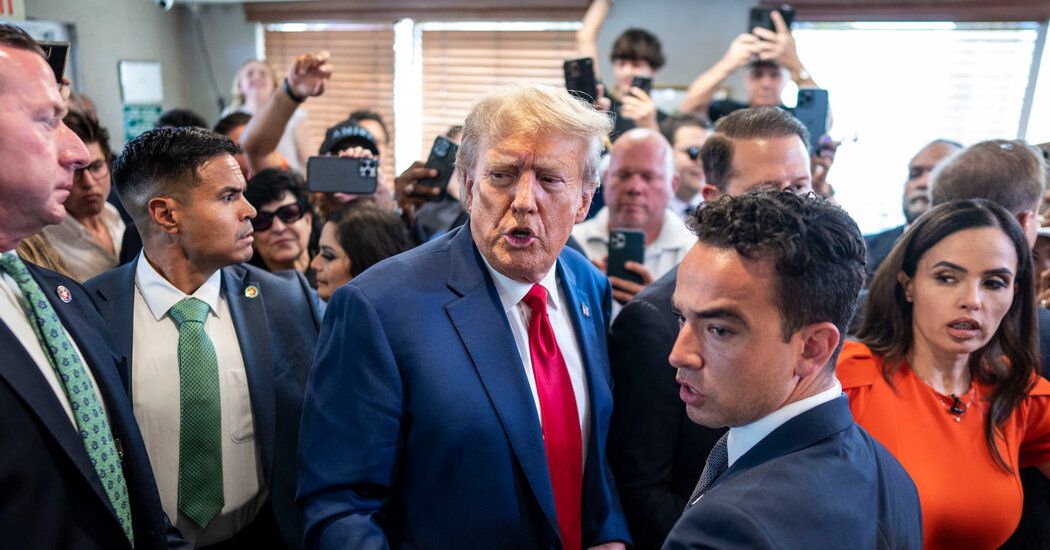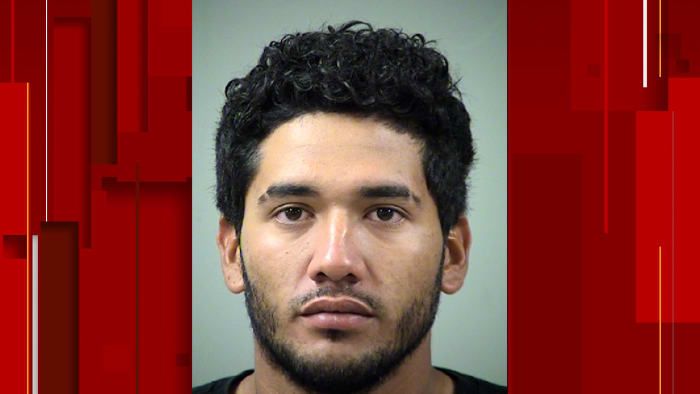Trump Arraignment Trump Pleads Not Guilty in Documents Case
In the days leading up to his arraignment in Miami, former President Donald J. Trump and several of his allies called on supporters to rally to his side.
Roger J. Stone Jr., Mr. Trump’s longtime political adviser, called for protests, insisting that they should be peaceful. A Miami chapter of the Proud Boys — long associated with Mr. Stone — echoed the invitation, posting a flier on its Telegram page last week advertising an event at the federal courthouse on Tuesday morning.
All of this raised the level of concern among civic leaders in the city, who issued calls for protesters to remain peaceful. In the end, their fears did not materialize. It did not appear that any Proud Boys showed up and about 500 people, including one with a pig’s head on a spear, answered Mr. Trump’s call to action.
The atmosphere outside the building was circuslike. There was the Uncle Sam who sped around the courthouse grounds on a two-wheeled hoverboard singing pro-Trump songs, the woman with a unicorn horn affixed to her forehead who wore an “Aunt-ifa” shirt and chanted derisively about the former president, and the man in a black-and-white jail jumpsuit carrying a sign that read, “Lock Him Up.”
That man in the jumpsuit later instigated the most hectic moment of the day, when he ran in front of Mr. Trump’s S.U.V. as it left the courthouse. The man, who was not immediately identified, was pushed out of the way by the police and later taken into custody. As officers took him away, a crowd of Trump supporters used the message on his sign to taunt him: “Lock him up!”
As he left, Mr. Trump, sitting in the back seat of the S.U.V., flashed a thumbs up to supporters, some of whom sprinted after the vehicle as they cheered. He headed to the famous Cuban restaurant Versailles, where a smaller crowd of supporters awaited him, a rabbi and minister prayed for him and he briefly shook hands and posed for photos.
It was the second time this year that Mr. Trump had called for protests at a court appearance, only to have his summons receive a kind of fizzled response. When he was arraigned in a separate case in April in Manhattan, the New York City Police Department mobilized in force over concerns about unrest, but the chaos never occurred.
In Miami, too, on a blazingly hot day thick with humidity, the crowd was calmer than some had feared. Miami’s police chief, Manuel Morales, faced tough questions from reporters a day earlier on whether he was doing enough to keep the area safe during the court proceeding and why he did not plan to separate anti-Trump and pro-Trump demonstrators.
“We know there is a potential of things taking a turn for the worse, but that’s not the Miami way,” he said in response.
The Proud Boys, who were founded during Mr. Trump’s first campaign for office, have rallied for years on his behalf, often violently. During the 2020 election, Mr. Trump notably called out the group, urging them during a presidential debate to “stand back and standby.”
Scores of Proud Boys took part in the attack on the U.S. Capitol on Jan. 6, 2021, and federal investigators cracked down hard on them in the aftermath. The group’s former leader, Enrique Tarrio, who is from Miami, was convicted of seditious conspiracy along with three of his lieutenants for their role in the attack. Dozens of other Proud Boys have either been charged or questioned by the authorities.
It is possible that the group never intended to take part in an event in Miami. It is also possible that the group has simply had enough of supporting Mr. Trump and suffering the consequences. After the violence at the Capitol, some high-ranking Proud Boys disavowed Mr. Trump, expressing anger at him for having left them standing on a limb.
As temperatures reached nearly 90 degrees by lunchtime, trucks circled around the courthouse with flags and loudspeakers, and several people on foot with selfie sticks broadcast live video streams to thousands of viewers while weaving in and out of the crowds.
“This is craaaazy,” shouted one pro-Trump streamer, Rafael Gomez, as he walked among the palm trees in front of the tall, shimmering courthouse. “Welcome to the banana republic of Miami!”
Also seeking to capture an audience were more established conservative figures, such as the Republican presidential candidate Vivek Ramaswamy, who held a news conference in front of the courthouse defending Mr. Trump and said that he would pardon his campaign rival if elected.
In an interview after his news conference, Mr. Ramaswamy said that despite his defense, he would not have done what Mr. Trump is accused of. “I wouldn’t have taken the boxes,” he said. “I’m not a memento guy. Not my style.”
The police largely stayed out of the way of the demonstrators, observing from close by while a helicopter circled overhead and jumping into the crowd only a few times when more hostile arguments sprouted up.
At one point, however, Homeland Security and Miami Police Department officers urgently closed in and began clearing a large area of the courthouse grounds. They investigated a large TV that had been affixed to a pole on the sidewalk and that bore a message criticizing what it called “the Communist-controlled news media.” About an hour later, the police removed the television and reopened the area.
Mayor Francis X. Suarez of Miami, a Republican who is mulling his own presidential bid, arrived in the early afternoon wearing a Miami Police Department polo shirt. He hugged several Trump supporters before shaking hands with a line of police officers. “I think, up until now, it’s a peaceful demonstration for people exercising their constitutional rights to express themselves, which we love about this country,” he said.
Nearby, Carlos Brito, 66, sold American flags for $5. Mr. Brito, who immigrated from Cuba in 1980, said he supported Mr. Trump and criticized President Biden for sending money to support Ukraine while Americans struggled financially. “Look how much a cup of coffee costs here,” he said. “We need help here at home.”
Scott Linnen, 61, a Trump critic from Miami, said he came to the courthouse because he had grown distraught over the direction of the country. As a gay man, he said he had seen a rise in anti-L.G.B.T.Q. rhetoric, hate speech and extremist behavior on the right.
“This man tried to overthrow the 247-year-old American experiment,” he said of Mr. Trump’s efforts to overturn the 2020 election. “I don’t understand why more people’s hair isn’t on fire.”
Luke Broadwater and Nick Madigan contributed reporting.
Source: The New York Times


